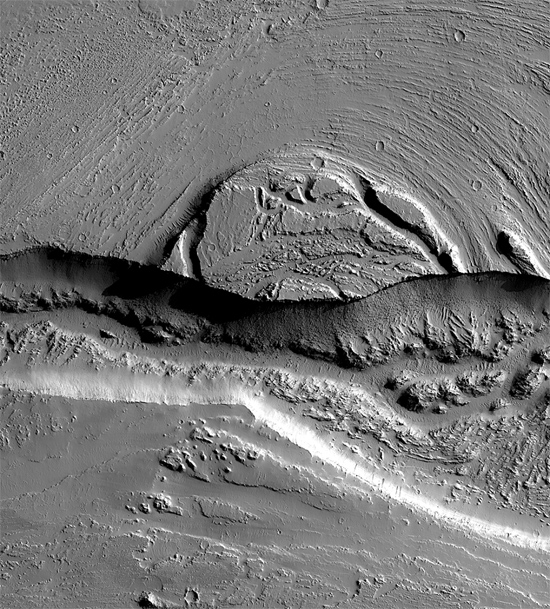Scientists from the
University of California
reported in June 2007 that a
“confirmation” for the Martian
liquid ocean theory was found:
“shorelines” extending for thousands
of kilometers around a large lake
that existed a little over three
billion years ago. It is speculated
that the "liquid oceans" have been
gone for over two billion years.
Planetary scientists have
correlated deep canyons,
ripples, and other
structures on Mars with floods of
water flowing on the surface,
eroding it in the same way as water
is supposed to erode features on
Earth. A theory supporting oceans of
water on Mars millions of years ago
seems to be contradicted by
mineralogical evidence, such as
deposits that would be destroyed by
water. The flowing water hypothesis
continues to guide consensus
theories, however.
According to a recent
press release, some
researchers are beginning to move
away from water as the active agent
in creating channels like the one
shown in the image at the top of the
page. Instead, lava flows are
thought to play a more significant
role than previously considered.
As David Leverington from Texas
Tech University wrote: “This paper
highlights the strengths and
weaknesses of the two theories that
these outflow channels were formed
by volcanic or water activity. Many
scientists realize there are issues
with aqueous interpretations of
these channels. They recognize that
if these systems formed by giant
subsurface flows of water, there
would need to have been
extraordinarily high ground
permeability, up to a million or
more times greater than what we’d
expect for the crust of the Earth,
just to allow sufficient amounts of
water to make it to the outflow
locations and erupt to the surface.”
The prevailing view of Mars is
that it is covered with a layer of
ice. The soil temperature has been
measured to be about minus 50
Celsius; so cold that carbon dioxide
freezes solid. If water exists, it
has to be locked in icy soils or in
underground vaults, since the
low-density atmosphere would cause
water-ice out in the open to sublime
to its vapor phase.
Several Mars missions were sent
to confirm the water hypothesis.
Clouds and low-lying fog were
reported, and the Phoenix lander is
reputed to have detected water just
below the surface, although there
has been no result that can stand up
to close scrutiny.
Despite what was called "visual
evidence," the devices used to test
for water returned a null reading.
The soil around Phoenix was
nonconductive, indicating no water.
Phoenix froze to death when it was
encased by almost 3 meters of frozen
carbon dioxide during the Martian
winter, so it is probable that it
was dry ice providing the visual
clue rather than water-ice.
Martian areography bears
witness to violent events in the Red
Planet's past.
Many images taken by the
Mars Reconnaissance Orbiter (MRO)
indicate that Mars was once the
scene of devastating plasma
discharges that, among other
effects, ripped out the northern
terrain to a depth of six kilometers
below the planet's mean elevation.
Burned
craters and
piles of scorched dust
lead to the conclusion that
lightning thousands or millions of
times more energetic than we know
today resurfaced Mars. The existence
of these formations constitutes a
confirmation of the Electric
Universe hypothesis.
Valles Marineris,
Olympus Mons, the
terraced mounds in
Arabia Terra, as well as
both Martian poles demonstrate
strong support for the electric
discharge theory.
It is possible that there are ice
deposits on Mars formed during the
catastrophic events that altered its
surface. The aforementioned plasma
discharges left behind sinuous
rilles, flat-floored craters,
"railroad track" patterns in
canyons, intersecting gullies, and
giant mesas with
Lichtenberg "whiskers."
Lightning of sufficient power can
compress material in the discharge
channel and accelerate it along with
the negative charge, forming a jet.
If the jet contains water vapor,
liquid water or even ice might form
inside the spinning Birkeland
filament due to z-pinch effects.
If this phenomenon were to be
scaled up to planetary dimensions,
the increased electric discharges
might have dumped quantities of ice
particles onto the surface that
clumped together into the frozen
piles of debris that MRO's imagers
allegedly detected.
The fact that areologists are
thinking about lava instead of water
is a step toward an understanding of
catastrophic evolution on Mars. If
what we find on Mars took place in
the presence of planetary lightning
bolts and was not the result of ice
or water moving across the surface,
should we rethink our ideas about
similar observations here on Earth?
Stephen Smith
 New
DVD
New
DVD
The Lightning-Scarred
Planet Mars
A video documentary that could
change everything you thought you
knew about ancient times and
symbols. In this second episode of
Symbols of an Alien Sky, David
Talbott takes the viewer on an
odyssey across the surface of Mars.
Exploring feature after feature of
the planet, he finds that only
electric arcs could produce the
observed patterns. The high
resolution images reveal massive
channels and gouges, great mounds,
and crater chains, none finding an
explanation in traditional geology,
but all matching the scars from
electric discharge experiments in
the laboratory. (Approximately 85
minutes)
Video Selections
Order Link





 New
DVD
New
DVD

